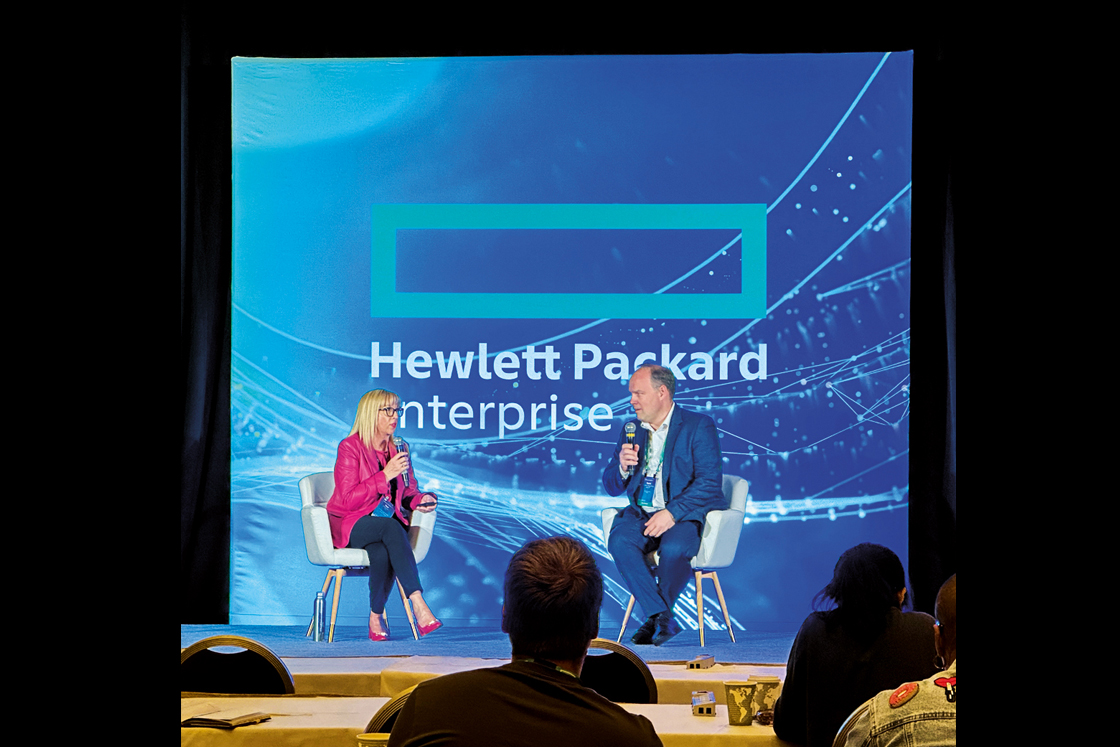Danfoss – Hewlett Packard Enterprise and Danfoss partner to curb data center energy consumption and reuse excess heat
- Enhanced modular data center accelerates AI and compute-intensive workloads at the edge with integrated heat capture systems for external reuse
- Enhanced modular data centers support rapid scaling of AI while utilizing energy-efficient solutions to reduce energy use and emissions
Hewlett Packard Enterprise (NYSE: HPE) and Danfoss today announced their collaboration to deliver HPE IT Sustainability Services – Data Center Heat Recovery, an off-the shelf heat recovery module, helping organizations manage and value excess[1] heat as they transition towards more sustainable IT facilities.
The rapid integration of AI technologies across organizations and businesses is expected to have a dramatic increase in the power demand and utilization of AI optimized IT infrastructure. According to the International Energy Agency, by 2026 the AI industry is expected to have grown exponentially to consume at least ten times its electricity demand in 2023[2].
To mitigate these challenges, IT leaders and data center facility operators are taking action to reduce energy usage, such as implementing modern power-efficient capabilities and improved cooling systems. Excess heat in the European Union alone represents an estimated 2,860 TWh/y, almost equals to the EU’s total energy demand for heat and hot water in residential and service sector buildings[3]. The flow of excess heat from data centers is uninterruptible and therefore constitutes a very reliable source of clean energy.
To address these issues, the new energy efficient data center solution from HPE and Danfoss offers:
- HPE’s scalable Modular Data Center (MDC), in the form of small footprint, high-density (kW/rack) containers, can be deployed nearly anywhere in the total absence of heavy industry and incorporates technologies such as direct liquid cooling, reducing overall energy consumption by 20%.
- Danfoss’ innovative solutions, including heat reuse modules that capture excess heat from data centers to provide renewable heating onsite and to neighboring buildings and industries for various applications, and Turbocor® oil-free compressors that enhance data center cooling efficiency by up to 30%.
Jürgen Fischer, President, Danfoss Climate Solutions, said:
“Our strategic partnership with HPE is a great example of how we revolutionize building and decarbonizing the data center industry together with customers. With this latest cross-industry partnership we’re building the blueprint for the next generation of sustainable datacenters – using technologies available today”.
Benefits and agility of modularity
HPE’s MDC incorporates direct liquid cooling (DLC) technologies to enhance energy efficiency by over 20% and optimize energy production and distribution, leading to notable energy savings. The design’s compactness minimizes energy loss by reducing the distance for energy and cooling fluid transport and maximizes the temperature differential at the inlet and outlet, which promotes the capture of excess heat. Furthermore, the MDC’s agility and the exclusion of heavy industrial materials negate the need for costly, conventional building materials and substantially reduces the time to market. Deployment can be achieved three times quicker than with traditional data centers, decreasing from 18 months to as few as 6 months. Finally, the reduced land footprint and flexibility of the MDCs allow for placement in proximity to data generation sites, which diminishes the energy impact and bottlenecks associated with complex networking solutions and data transfer, while also supporting enhanced data governance and security.
Sue Preston, Vice President & General Manager, WW Advisory & Professional Services & Managed Services, HPE, said:
“At HPE, we believe in the power of collaboration to create transformative solutions. Our partnership with Danfoss brings together HPE’s innovative modular data center with Danfoss’ groundbreaking heat reuse technology. Together, we are not just adding value; we are multiplying it. By harnessing the typically untapped resource of waste heat, turning waste into worth, showing the future of energy usage is efficient, intelligent, and, most importantly, achievable now.”
With unparalleled density, HPE’s modular data centers offer an impressive power usage effectiveness (PUE) of 1.1[4] in contrast to the PUE of 1.3 to 1.4 typically associated with the best modern designs of traditional brick-and-mortar data centers. Capable of handling the most power-demanding architectures like HPE Cray Supercomputing EX4000, HPE’s modular data center is the adequate architecture for mission critical and compute intensive workloads like supercomputing and generative AI, enabling scientists, universities, and enterprises to achieve faster outcomes.
From chip to chiller: driving innovation in decarbonization
To leverage excess heat – one of the largest untapped sources of energy and the largest potential for data centers across Europe, HPE has partnered up with Danfoss as their decarbonization partner. The strategic partnership takes advantage of Danfoss’ extensive product portfolio of energy-efficient solutions to drive innovation, support decarbonization and build the blueprint for the next generation of sustainable modular data centers.
HPE IT Sustainability Services – Data Center Heat Recovery is inspired by how Danfoss is already using heat reuse technology at its own headquarters campus in Denmark. Here, the heat is recovered from Danfoss’ onsite data center, boosted by a heat pump, and re-used in surrounding buildings to provide space heating. The heat can also be fed into the local district heating network to provide a renewable heat source to local residents. Reusing heat is a major part of Danfoss’ own decarbonization strategy which has helped Danfoss achieve carbon neutrality in the energy system of its 250,000m2 campus in Nordborg in 2022.
The new scalable modular data center offering leverages Danfoss technologies, including Turbocor® compressors for heat pumps and chillers, heat exchangers, heat reuse modules, drives and pump skids allowing data centers to be cooled up to 30% more efficiently while recovering and reusing excess heat. It’s a modular solution with components that work together seamlessly and includes two technology stack options with a heat recovery system, including hydronic heat recovery heat exchanger and water-water heat pump, recovering heat from an air-cooled edge-to-cloud modular data center today and potentially second phase liquid cooled HPC modular data center.
As part of its holistic “Reduce, Reuse, Resource” approach, Danfoss also partners with HPE to retire its end-of-use IT assets through HPE Asset Upcycling Services, a circular economy solution that enables technology refurbishment and reuse, while recovering economic value from those assets.
Availability
HPE IT Sustainability Services – Data Center Heat Recovery is available to order immediately.
References
- Excess heat, also called surplus heat or waste heat, can be reused through existing and well-proven technologies, most notably heat pumps. Excess heat – Danfoss Impact Issue no. 2
- Electricity 2024 – Analysis and forecast to 2026 (iea.blob.core.windows.net)
- Excess heat – Danfoss Impact Issue no. 2
- When using Direct Liquid Cooling (DLC) technologies.
SourceDanfoss
EMR Analysis
More information on Danfoss: See the full profile on EMR Executive Services
More information on Kim Fausing (President and Chief Executive Officer, Danfoss): See the full profile on EMR Executive Services
More information on Jürgen Fischer (Member of the Group Executive Team (GET), President, Danfoss Climate Solutions, Danfoss): See the full profile on EMR Executive Services
More information on Danfoss Turbocor® Compressors: https://www.danfoss.com/en/products/dcs/compressors/turbocor/ +
The world’s leader in oil-free compressor technology.
Danfoss is the leading manufacturer of oil free compressors and is the pioneer of the Danfoss Turbocor® compressor – the world’s first oil-free magnetic bearing compressor for the HVAC industry.
Danfoss Turbocor® compressors use advanced technology to deliver high efficiency and low sound levels in a compact footprint. Industry leading performance is achieved by using oil free, magnetic bearings that provide world class efficiency and zero performance degradation over the life of the compressor. Permanent magnet motors and variable speed drives provide unmatched full and part load efficiency.
Danfoss Turbocor® oil-free centrifugal compressors have the flexibility to be used in air cooled, water cooled or evaporative cooled chillers operating in wide range of applications such as comfort cooling, low temperature process, ice storage and heat recovery. This flexibility has resulted in over 70,000 compressors installed in jobsites around the world.
Danfoss Turbocor® compressors are manufactured in Tallahassee, Florida and Shanghai, China in a ISO 9001:2015 and ISO 14001:2015 certified facility. Sales and service centers are located in the USA, Europe and Asia to serve customers around the world.
Danfoss Turbocor® technology has been recognized with awards from many prestigious organizations including the USA EPA, AHRI/ASHRAE USA, Natural Resources Canada and the Institute of Refrigeration – England.
More information on Ricardo Schneider (President, Danfoss Turbocor® Compressors, Danfoss): See the full profile on EMR Executive Services
More information on Hewlett Packard Enterprise (HPE): https://www.hpe.com/us/en/home.html +HPE is the global edge-to-cloud company built to transform your business. How? By helping you connect, protect, analyze, and act on all your data and applications wherever they live, from edge to cloud, so you can turn insights into outcomes at the speed required to thrive in today’s complex world.
Hewlett Packard Enterprise (NYSE: HPE) is the global edge-to-cloud company that helps organizations accelerate outcomes by unlocking value from all of their data, everywhere. Built on decades of reimagining the future and innovating to advance the way people live and work, HPE delivers unique, open and intelligent technology solutions as a service.With offerings spanning Cloud Services, Compute, High Performance Computing & AI, Intelligent Edge, Software, and Storage, HPE provides a consistent experience across all clouds and edges, helping customers develop new business models, engage in new ways, and increase operational performance.
More information on Antonio Neri (President & Chief Executive Officer, Hewlett Packard Enterprise): https://www.hpe.com/us/en/leadership-bios/antonio-neri.html + https://www.linkedin.com/in/antonio-neri-hpe/
More information on Sue Preston (Vice President & General Manager, WW Advisory & Professional Services & Managed Services, Hewlett Packard Enterprise): https://www.linkedin.com/in/sue-preston-577918/
More information on IEA (International Energy Agency): https://www.iea.org + The IEA is at the heart of global dialogue on energy, providing authoritative analysis, data, policy recommendations, and real-world solutions to help countries provide secure and sustainable energy for all.
The IEA was created in 1974 to help co-ordinate a collective response to major disruptions in the supply of oil. While oil security this remains a key aspect of our work, the IEA has evolved and expanded significantly since its foundation.
Taking an all-fuels, all-technology approach, the IEA recommends policies that enhance the reliability, affordability and sustainability of energy. It examines the full spectrum issues including renewables, oil, gas and coal supply and demand, energy efficiency, clean energy technologies, electricity systems and markets, access to energy, demand-side management, and much more.
Since 2015, the IEA has opened its doors to major emerging countries to expand its global impact, and deepen cooperation in energy security, data and statistics, energy policy analysis, energy efficiency, and the growing use of clean energy technologies.
More information on Dr. Fatih Birol (Executive Director, International Energy Agency): https://www.iea.org/contributors/dr-fatih-birol + https://www.linkedin.com/in/fatih-birol/
More information on The European Union: https://european-union.europa.eu/index_en + The European Union’s institutional set-up is unique and its decision-making system is constantly evolving. The 7 European institutions, 7 EU bodies and over 30 decentralised agencies are spread across the EU. They work together to address the common interests of the EU and European people.
In terms of administration, there are a further 20 EU agencies and organisations which carry out specific legal functions and 4 interinstitutional services which support the institutions.
All of these establishments have specific roles – from developing EU laws and policy-making to implementing policies and working on specialist areas, such as health, medicine, transport and the environment.
There are 4 main decision-making institutions which lead the EU’s administration. These institutions collectively provide the EU with policy direction and play different roles in the law-making process:
- the European Parliament (Brussels/Strasbourg/Luxembourg)
- the European Council (Brussels)
- the Council of the European Union (Brussels/Luxembourg)
- the European Commission (Brussels/Luxembourg/Representations across the EU)
Their work is complemented by other institutions and bodies, which include:
- the Court of Justice of the European Union (Luxembourg)
- the European Central Bank (Frankfurt)
- the European Court of Auditors (Luxembourg)
The EU institutions and bodies cooperate extensively with the network of EU agencies and organisations across the European Union. The primary function of these bodies and agencies is to translate policies into realities on the ground.
Around 60,000 EU civil servants and other staff serve the 450 million Europeans (and countless others around the world).
Currently, 27 countries are part of the EU: https://european-union.europa.eu/principles-countries-history/country-profiles_en
More information on The European Commission: https://ec.europa.eu/info/index_en + The Commission helps to shape the EU’s overall strategy, proposes new EU laws and policies, monitors their implementation and manages the EU budget. It also plays a significant role in supporting international development and delivering aid.
The Commission is steered by a group of 27 Commissioners, known as ‘the college’. Together they take decisions on the Commission’s political and strategic direction.
A new college of Commissioners is appointed every 5 years.
The Commission is organised into policy departments, known as Directorates-General (DGs), which are responsible for different policy areas. DGs develop, implement and manage EU policy, law, and funding programmes. In addition, service departments deal with particular administrative issues. Executive agencies manage programmes set up by the Commission.
Principal roles in law: The Commission proposes and implements laws which are in keeping with the objectives of the EU treaties. It encourages input from business and citizens in the law-making process and ensures laws are correctly implemented, evaluated and updated when needed.
More information on Ursula von der Leyen (President, The European Commission): https://ec.europa.eu/commission/commissioners/2019-2024/president_en + https://www.linkedin.com/in/ursula-von-der-leyen/
EMR Additional Notes:
- Cloud Computing:
- Cloud computing is a general term for anything that involves delivering hosted services over the internet. … Cloud computing is a technology that uses the internet for storing and managing data on remote servers and then access data via the internet.
- Cloud computing is the on-demand availability of computer system resources, especially data storage and computing power, without direct active management by the user. Large clouds often have functions distributed over multiple locations, each location being a data center.
- Edge Computing:
- Edge computing is a form of computing that is done on site or near a particular data source, minimizing the need for data to be processed in a remote data center.
- Edge computing can enable more effective city traffic management. Examples of this include optimising bus frequency given fluctuations in demand, managing the opening and closing of extra lanes, and, in future, managing autonomous car flows.
- An edge device is any piece of hardware that controls data flow at the boundary between two networks. Edge devices fulfill a variety of roles, depending on what type of device they are, but they essentially serve as network entry — or exit — points.
- There are five main types of edge computing devices: IoT sensors, smart cameras, uCPE equipment, servers and processors. IoT sensors, smart cameras and uCPE equipment will reside on the customer premises, whereas servers and processors will reside in an edge computing data centre.
- In service-based industries such as the finance and e-commerce sector, edge computing devices also have roles to play. In this case, a smart phone, laptop, or tablet becomes the edge computing device.
- Edge Devices:
- Edge devices encompass a broad range of device types, including sensors, actuators and other endpoints, as well as IoT gateways. Within a local area network (LAN), switches in the access layer — that is, those connecting end-user devices to the aggregation layer — are sometimes called edge switches.
- Data Centers:
- A data center is a facility that centralizes an organization’s shared IT operations and equipment for the purposes of storing, processing, and disseminating data and applications. Because they house an organization’s most critical and proprietary assets, data centers are vital to the continuity of daily operations.
- Hyperscale Data Centers:
- The clue is in the name: hyperscale data centers are massive facilities built by companies with vast data processing and storage needs. These firms may derive their income directly from the applications or websites the equipment supports, or sell technology management services to third parties.
- AI – Artificial Intelligence:
- https://searchenterpriseai.techtarget.com/definition/AI-Artificial-Intelligence +
- Artificial intelligence is the simulation of human intelligence processes by machines, especially computer systems.
- As the hype around AI has accelerated, vendors have been scrambling to promote how their products and services use AI. Often what they refer to as AI is simply one component of AI, such as machine learning. AI requires a foundation of specialized hardware and software for writing and training machine learning algorithms. No one programming language is synonymous with AI, but well a few, including Python, R and Java, are popular.
- In general, AI systems work by ingesting large amounts of labeled training data, analyzing the data for correlations and patterns, and using these patterns to make predictions about future states. In this way, a chatbot that is fed examples of text chats can learn to produce lifelike exchanges with people, or an image recognition tool can learn to identify and describe objects in images by reviewing millions of examples.
- AI programming focuses on three cognitive skills: learning, reasoning and self-correction.
- What are the 4 types of artificial intelligence?
- Type 1: Reactive machines. These AI systems have no memory and are task specific. An example is Deep Blue, the IBM chess program that beat Garry Kasparov in the 1990s. Deep Blue can identify pieces on the chessboard and make predictions, but because it has no memory, it cannot use past experiences to inform future ones.
- Type 2: Limited memory. These AI systems have memory, so they can use past experiences to inform future decisions. Some of the decision-making functions in self-driving cars are designed this way.
- Type 3: Theory of mind. Theory of mind is a psychology term. When applied to AI, it means that the system would have the social intelligence to understand emotions. This type of AI will be able to infer human intentions and predict behavior, a necessary skill for AI systems to become integral members of human teams.
- Type 4: Self-awareness. In this category, AI systems have a sense of self, which gives them consciousness. Machines with self-awareness understand their own current state. This type of AI does not yet exist.
- Machine Learning (ML):
- Developed to mimic human intelligence, it lets the machines learn independently by ingesting vast amounts of data, statistics formulas and detecting patterns.
- ML allows software applications to become more accurate at predicting outcomes without being explicitly programmed to do so.
- ML algorithms use historical data as input to predict new output values.
- Recommendation engines are a common use case for ML. Other uses include fraud detection, spam filtering, business process automation (BPA) and predictive maintenance.
- Classical ML is often categorized by how an algorithm learns to become more accurate in its predictions. There are four basic approaches: supervised learning, unsupervised learning, semi-supervised learning and reinforcement learning.
- Deep Learning (DL):
- Subset of machine learning, Deep Learning enabled much smarter results than were originally possible with ML. Face recognition is a good example.
- DL makes use of layers of information processing, each gradually learning more and more complex representations of data. The early layers may learn about colors, the next ones about shapes, the following about combinations of those shapes, and finally actual objects. DL demonstrated a breakthrough in object recognition.
- DL is currently the most sophisticated AI architecture we have developed.
- Computer Vision (CV):
- Computer vision is a field of artificial intelligence that enables computers and systems to derive meaningful information from digital images, videos and other visual inputs — and take actions or make recommendations based on that information.
- The most well-known case of this today is Google’s Translate, which can take an image of anything — from menus to signboards — and convert it into text that the program then translates into the user’s native language.
- Machine Vision (MV):
- Machine Vision is the ability of a computer to see; it employs one or more video cameras, analog-to-digital conversion and digital signal processing. The resulting data goes to a computer or robot controller. Machine Vision is similar in complexity to Voice Recognition.
- MV uses the latest AI technologies to give industrial equipment the ability to see and analyze tasks in smart manufacturing, quality control, and worker safety.
- Computer Vision systems can gain valuable information from images, videos, and other visuals, whereas Machine Vision systems rely on the image captured by the system’s camera. Another difference is that Computer Vision systems are commonly used to extract and use as much data as possible about an object.
- Generative AI (GenAI):
- Generative AI technology generates outputs based on some kind of input – often a prompt supplied by a person. Some GenAI tools work in one medium, such as turning text inputs into text outputs, for example. With the public release of ChatGPT in late November 2022, the world at large was introduced to an AI app capable of creating text that sounded more authentic and less artificial than any previous generation of computer-crafted text.
- https://searchenterpriseai.techtarget.com/definition/AI-Artificial-Intelligence +
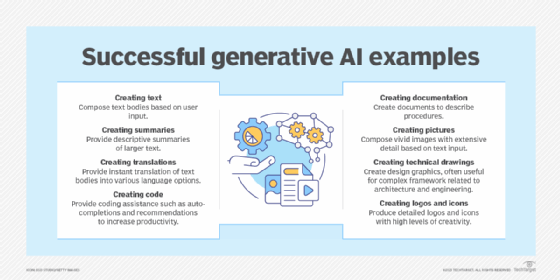
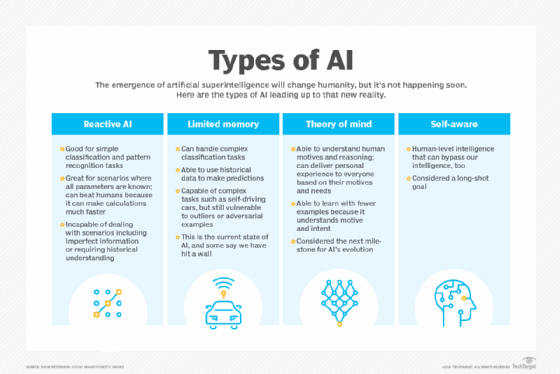
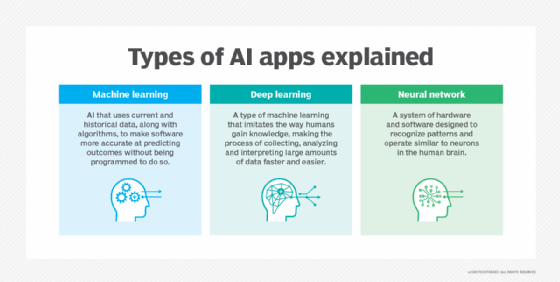
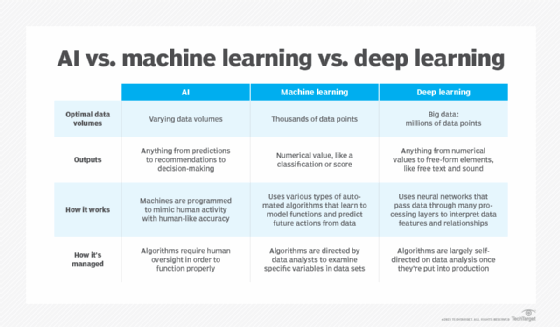
- Edge AI Technology:
- Edge artificial intelligence refers to the deployment of AI algorithms and AI models directly on local edge devices such as sensors or Internet of Things (IoT) devices, which enables real-time data processing and analysis without constant reliance on cloud infrastructure.
- Simply stated, edge AI, or “AI on the edge“, refers to the combination of edge computing and artificial intelligence to execute machine learning tasks directly on interconnected edge devices. Edge computing allows for data to be stored close to the device location, and AI algorithms enable the data to be processed right on the network edge, with or without an internet connection. This facilitates the processing of data within milliseconds, providing real-time feedback.
- Self-driving cars, wearable devices, security cameras, and smart home appliances are among the technologies that leverage edge AI capabilities to promptly deliver users with real-time information when it is most essential.
- Information Technology (IT) & Operational Technology (OT):
- Information technology (IT) refers to anything related to computer technology, including hardware and software. Your email, for example, falls under the IT umbrella. This form of technology is less common in industrial settings, but often constitutes the technological backbone of most organizations and companies. These devices and programs have little autonomy and are updated frequently.
- Operational technology (OT) refers to the hardware and software used to change, monitor, or control physical devices, processes, and events within a company or organization. This form of technology is most commonly used in industrial settings, and the devices this technology refers to typically have more autonomy than information technology devices or programs. Examples of OT include SCADA (Supervisory Control and Data Acquisition).
- => The main difference between OT and IT devices is that OT devices control the physical world, while IT systems manage data.
- Kilowatt (kW):
- A kilowatt is simply a measure of how much power an electric appliance consumes—it’s 1,000 watts to be exact. You can quickly convert watts (W) to kilowatts (kW) by diving your wattage by 1,000: 1,000W 1,000 = 1 kW.
- Megawatt (MW):
- One megawatt equals one million watts or 1,000 kilowatts, roughly enough electricity for the instantaneous demand of 750 homes at once.
- Gigawatt (GW):
- A gigawatt (GW) is a unit of power, and it is equal to one billion watts.
- According to the Department of Energy, generating one GW of power takes over three million solar panels or 310 utility-scale wind turbines
- Terawatt (TW):
- One terawatt is equal to 1,000,000,000,000 watts.
- The main use of terawatts is found in the electric power industry.
- According to the United States Energy Information Administration, America is one of the largest electricity consumers in the world using about 4,146.2 terawatt-hours.
- Carbon Dioxide (CO2):
- Primary greenhouse gas emitted through human activities. Carbon dioxide enters the atmosphere through burning fossil fuels (coal, natural gas, and oil), solid waste, trees and other biological materials, and also as a result of certain chemical reactions (e.g., manufacture of cement). Carbon dioxide is removed from the atmosphere (or “sequestered”) when it is absorbed by plants as part of the biological carbon cycle.
- Biogenic Carbon Dioxide (CO2):
- Carbon Dioxide released as a result of the combustion or decomposition of organic material, that is biomass and its derivatives. Examples include carbon dioxide released during the combustion of wood and biogas generated by decomposition.
- Biogenic Carbon Dioxide (CO2) and Carbon Dioxide (CO2) are the same. Scientists differentiate between biogenic carbon (that which is absorbed, stored and emitted by organic matter like soil, trees, plants and grasses) and non-biogenic carbon (that found in all other sources, most notably in fossil fuels like oil, coal and gas).
- Carbon Capture and Storage (CCS):
- CCS involves the capture of carbon dioxide (CO2) emissions from industrial processes, such as steel and cement production, or from the burning of fossil fuels in power generation. This carbon is then transported from where it was produced, via ship or in a pipeline, and stored deep underground in geological formations.
- CCS projects typically target 90 percent efficiency, meaning that 90 percent of the carbon dioxide from the power plant will be captured and stored.
- Decarbonization:
- Reduction of carbon dioxide emissions through the use of low carbon power sources, achieving a lower output of greenhouse gasses into the atmosphere.
- Carbon Footprint:
- There is no universally agreed definition of what a carbon footprint is. A carbon footprint is generally understood to be the total amount of greenhouse gas (GHG) emissions that are directly or indirectly caused by an individual, organization, product, or service. These emissions are typically measured in tonnes of carbon dioxide equivalent (CO2e).
- In 2009, the Greenhouse Gas Protocol (GHG Protocol) published a standard for calculating and reporting corporate carbon footprints. This standard is widely accepted by businesses and other organizations around the world. The GHG Protocol defines a carbon footprint as “the total set of greenhouse gas emissions caused by an organization, directly and indirectly, through its own operations and the value chain.”
- Carbon Credits or Carbon Offsets:
- Permits that allow the owner to emit a certain amount of carbon dioxide or other greenhouse gases. One credit permits the emission of one ton of carbon dioxide or the equivalent in other greenhouse gases.
- The carbon credit is half of a so-called cap-and-trade program. Companies that pollute are awarded credits that allow them to continue to pollute up to a certain limit, which is reduced periodically. Meanwhile, the company may sell any unneeded credits to another company that needs them. Private companies are thus doubly incentivized to reduce greenhouse emissions. First, they must spend money on extra credits if their emissions exceed the cap. Second, they can make money by reducing their emissions and selling their excess allowances.
- CO2e:
- CO2e means “carbon dioxide equivalent”. In layman’s terms, CO2e is a measurement of the total greenhouse gases emitted, expressed in terms of the equivalent measurement of carbon dioxide. On the other hand, CO2 only measures carbon emissions and does not account for any other greenhouse gases.
- A carbon dioxide equivalent or CO2 equivalent, abbreviated as CO2-eq is a metric measure used to compare the emissions from various greenhouse gases on the basis of their global-warming potential (GWP), by converting amounts of other gases to the equivalent amount of carbon dioxide with the same global warming potential.
- Carbon dioxide equivalents are commonly expressed as million metric tonnes of carbon dioxide equivalents, abbreviated as MMTCDE.
- The carbon dioxide equivalent for a gas is derived by multiplying the tonnes of the gas by the associated GWP: MMTCDE = (million metric tonnes of a gas) * (GWP of the gas).
- For example, the GWP for methane is 25 and for nitrous oxide 298. This means that emissions of 1 million metric tonnes of methane and nitrous oxide respectively is equivalent to emissions of 25 and 298 million metric tonnes of carbon dioxide.
- Blueprint:
- A blueprint is a guide for making something — it’s a design or pattern that can be followed. Want to build the best tree house ever? Draw up a blueprint and follow the design carefully. The literal meaning of a blueprint is a paper — which is blue — with plans for a building printed on it.
- After the paper was washed and dried to keep those lines from exposing, the result was a negative image of white (or whatever color the blueprint paper originally was) against a dark blue background. The resulting image was therefore appropriately named “blueprint.”.
- By definition, a blueprint is a drawing up of a plan or model. The blueprint perspective allows you to see all the pieces needed to assemble your business before you begin.
- Data Center PUE (Power Usage Effectiveness):
- Metric used to determine the energy efficiency of a data center. PUE is determined by dividing the total amount of power entering a data center by the power used to run the IT equipment within it. PUE is expressed as a ratio, with overall efficiency improving as the quotient decreases toward 1.0.
- Data center infrastructure and the processing power within it require a lot of energy, and data centers that do not operate efficiently will use more energy.
- PUE was created by members of the Green Grid, an industry group focused on data center energy efficiency.
- The calculation of power usage effectiveness is total facility power/IT equipment energy = PUE. Total facility power is the amount of power the facility uses, which includes all data center hardware, power delivery components, cooling systems and lighting systems. IT equipment energy refers to the amount of energy that is used to power the storage and networking equipment as well as control equipment such as monitors and workstations.
- Geothermal Heating, Heat Pumps, Chillers & Hydronics:
- Geothermal heating and cooling systems take advantage of the stable temperature underground using a piping system, commonly referred to as a “loop.” Water circulates in the loop to exchange heat between your home, the ground source heat pump, and the earth, providing geothermal heating, cooling, and hot water at remarkably high efficiencies.
- Heat pumps use electricity to transfer heat from a cool space to a warm space, making the cool space cooler and the warm space warmer. During the heating season, heat pumps move heat from the cool outdoors into your warm house. During the cooling season, heat pumps move heat from your house into the outdoors. Because they transfer heat rather than generate heat, heat pumps can efficiently provide comfortable temperatures for your home.
- The only difference between a heat pump and a chiller is that one is designed to remove heat from a space or process stream, making it cooler and rejecting heat to the environment, while the other is designed to extract heat from the environment and use it to provide useful heat.
- Hydronics are systems of heating or cooling that involves transfer of heat by a circulating fluid (such as water or vapor) in a closed system of pipes.


